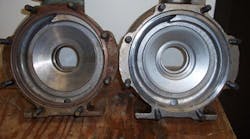King Industries operates a specialty chemical manufacturing facility in Norwalk, Conn. The site has numerous horizontal centrifugal pumps, ranging from 1 to 20 hp. These pumps typically are open impeller units with single or double mechanical seals and foot-mounted electric motors.
During the spring of 2010 the maintenance department was alerted to a problem with one of these pumps. This unit was a typical centrifugal pump, 7.5 hp. operating at 3,600 rpm. It was reported to be demonstrating excessive vibration that actually was audible to the operator when approaching the pump. Evaluation and correction of vibration and noise were required.
Initially, maintenance staff focused on shaft alignment, thinking it could cause the excessive noise. A laser alignment device revealed misalignment. However, correcting the alignment didn't improve vibration and noise level.
Next, the bearing frame of the pump was removed. Shop inspection showed the open impeller had signs of gouging and scoring of the stainless steel. We also checked the pump shaft for run-out — it was within normal limits. The impeller was sent to a local electrical shop for balancing. The impeller was found to be out of balance and an attempt was made to rebalance it. The components then were reassembled on the pump base and the pump was operated to re-evaluate performance. We observed no improvement in the levels of vibration or noise. So, we replaced the scored impeller with a new one. This had no significant effect on the vibration level.
At this point we called in the manufacturer's representative to evaluate this pump. Maintenance craft workers removed the bearing frame so the rep could inspect the volute casing, impeller, shaft and bearings. There was severe erosion/corrosion of the stainless steel volute case around the pump inlet (Figure 1). Normally in such a centrifugal pump there's relatively close clearance between the volute case and the impeller (approximately 0.015 in.). Due to the wear in the volute case clearance exceeded 0.5 in. So, a spare casing was installed and the pump was reassembled.
Upon startup we noticed an immediate improvement in ambient vibration and noise level. Indeed, the pump now was running very quietly and smoothly. Vibration level had fallen by 90% to 0.05 in./sec., well within acceptable levels, from an average 0.4 to 0.5 in./sec.
The casing wear stemmed from routine processing. Solids within the pumping solution eventually eroded the inlet area of the volute case, resulting in wear seen in Figure 1. The solution does undergo some level of solids filtering, so the wear occurs quite gradually. The pump design and construction are sound; no additional filtering is currently available.
Therefore when conducting maintenance, e.g., seal replacement, it's important to carefully examine the amount of wear and address it when necessary. Also, we've implemented vibration monitoring as part of the routine proactive maintenance applied to the pump.
The significant learning from our experience is that centrifugal pump volute casing wear can result in excessive vibration and noise — so, don't automatically assume that mechanical looseness is the cause of such problems. We now better manage long-term erosion using both visual inspection and reliability-based technology such as vibration analysis.
Tom Buono, PE, is a maintenance reliability engineer at King Industries, Norwalk, Conn. Mark Vowell, CMRP, is a technical/applications engineer for Commtest, Inc., Knoxville, Tenn. E-mail them at [email protected] and [email protected].

